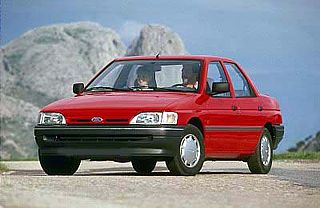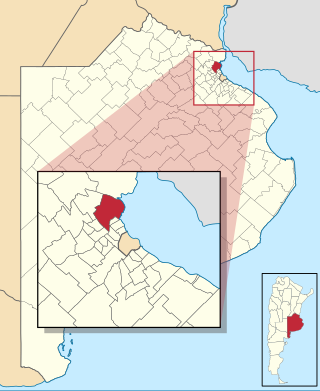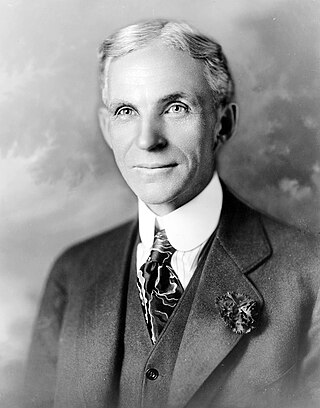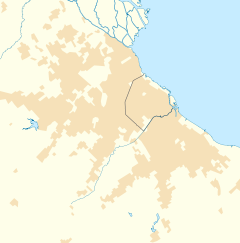
The United Auto Workers (UAW), fully named International Union, United Automobile, Aerospace and Agricultural Implement Workers of America, is an American labor union that represents workers in the United States and southern Ontario, Canada. It was founded as part of the Congress of Industrial Organizations (CIO) in the 1930s and grew rapidly from 1936 to the 1950s. The union played a major role in the liberal wing of the Democratic Party under the leadership of Walter Reuther. It was known for gaining high wages and pensions for automotive manufacturing workers, but it was unable to unionize auto plants built by foreign-based car makers in the South after the 1970s, and it went into a steady decline in membership; reasons for this included increased automation, decreased use of labor, mismanagement, movements of manufacturing, and increased globalization.

The Ford Versailles was a mid-size automobile between 1991 and 1996 in Brazil and Argentina. It was a version of the Volkswagen Santana sold in the 1990s, when Ford and Volkswagen shared models in South America in a joint venture known as Autolatina. It replaced the Ford Del Rey in Brazil and the locally built Ford Sierra in Argentina. The station wagon version was sold as the Ford Royale.

The Ford Verona and Volkswagen Apollo are a pair of small family cars that were manufactured in Brazil by Autolatina, a joint venture between Brazilian subsidiaries of Ford and Volkswagen. The Verona was produced from 1989 to 1992 and from 1993 to 1996, initially as a direct replacement for the ageing Ford Del Rey.

A car platform is a shared set of common design, engineering, and production efforts, as well as major components, over a number of outwardly distinct models and even types of cars, often from different, but somewhat related, marques. It is practiced in the automotive industry to reduce the costs associated with the development of products by basing those products on a smaller number of platforms. This further allows companies to create distinct models from a design perspective on similar underpinnings. A car platform is not to be confused with a platform chassis, although such a chassis can be part of an automobile's design platform, as noted below.

Tigre Partido is a partido of Buenos Aires Province, Argentina, situated in the northern part of Greater Buenos Aires. The department covers a large section of the Paraná Delta and its low-lying islands. The main town of the division is Tigre; other towns include Don Torcuato, El Talar, General Pacheco, Benavídez.

Ford Brasil is the Brazilian subsidiary of American automaker Ford Motor Company, founded on April 24, 1919. The operation started out importing the Ford Model T cars and the Ford Model TT trucks in kit form from the United States for assembly in Brazil. The Ford brand, however, had already been present in the country since 1904 with both vehicles being sold in Brazil.

The Ford Motor Company is an American automaker, the world's fifth largest based on worldwide vehicle sales. Based in Dearborn, Michigan, a suburb of Detroit, it was founded by Henry Ford on June 16, 1903. Ford Motor Company would go on to become one of the largest and most profitable companies in the world. The largest family-controlled company in the world, the Ford Motor Company has been in continuous family control for over 110 years. Ford now encompasses two brands: Ford and Lincoln. Ford once owned 5 other luxury brands: Volvo, Land Rover, Jaguar, Aston Martin, and Mercury. Over time, those brands were sold to other companies and Mercury was discontinued.
A collective agreement, collective labour agreement (CLA) or collective bargaining agreement (CBA) is a written contract negotiated through collective bargaining for employees by one or more trade unions with the management of a company that regulates the terms and conditions of employees at work. This includes regulating the wages, benefits, and duties of the employees and the duties and responsibilities of the employer or employers and often includes rules for a dispute resolution process.

Ford Argentina S.C.A. is the Argentine subsidiary of Ford Motor Company founded in Buenos Aires in 1913. Its first products were Model Ts assembled from complete knock down (CKD) kits provided by Ford Motor Company in 1917. Nevertheless, Ford Motor Argentina is best known in more recent times for producing the Ford Focus and, previously, the Argentine version of the Ford Falcon, originally a U.S. model introduced in Argentina in 1961, but adapted to the Argentine market.

The Brazilian automotive industry is coordinated by the Associação Nacional dos Fabricantes de Veículos Automotores (Anfavea), created in 1956, which includes automakers with factories in Brazil. Anfavea is part of the Organisation Internationale des Constructeurs d'Automobiles (OICA), based in Paris. In 2021, the annual production exceeded 2.2 million vehicles, the 8th largest in the world.

In the United States, the automotive industry began in the 1890s and, as a result of the size of the domestic market and the use of mass production, rapidly evolved into the largest in the world. The United States was the first country in the world to have a mass market for vehicle production and sales and is a pioneer of the automotive industry and mass market production process. During the 20th century, global competitors emerged, especially in the second half of the century primarily across European and Asian markets, such as Germany, France, Italy, Japan and South Korea. The U.S. is currently second among the largest manufacturers in the world by volume.
This article provides an overview of the automotive industry in countries around the world.

The Volkswagen Chattanooga Assembly Plant is an American automobile assembly plant in Chattanooga, Tennessee. The plant was formally announced in July 2008 and was formally inaugurated in May 2011.
Sevel Argentina S.A. was an Argentine automobile company established in 1981 that produced and marketed Fiat, Peugeot, Alfa Romeo, Chevrolet, and Citroën vehicles for the local market until it was dissolved in 1999. The company was created by merging Fiat's and Peugeot's Argentine operations.

Ford Motor Company is an American multinational automobile manufacturer headquartered in Dearborn, Michigan, United States. It was founded by Henry Ford and incorporated on June 16, 1903. The company sells automobiles and commercial vehicles under the Ford brand, and luxury cars under its Lincoln brand. Ford also owns a 32% stake in China's Jiangling Motors. It also has joint ventures in China, Taiwan, Thailand, and Turkey. The company is listed on the New York Stock Exchange and is controlled by the Ford family; they have minority ownership but the majority of the voting power.

The Wolfsburg Volkswagen Factory is the worldwide headquarters of the Volkswagen Group, and one of the largest manufacturing plants in the world, in terms of area at just under 6.5 million m². The Wolfsburg plant produced 815,000 cars in 2015. Volkswagen's currywurst is also produced at this facility.

Volkswagen Group Argentina is the Argentine subsidiary of German automotive manufacturing company Volkswagen Group. It was established in 1980 when the company acquired defunct business Chrysler Fevre Argentina including its two plants in San Justo and Monte Chingolo.

The automotive industry in the Philippines is one of the largest in the Asia-Pacific region, with approximately 441.4 thousand vehicles sold in 2023. Most of the vehicles sold and built in the Philippines are from foreign brands. For the most part, the Philippines is dominated by Japanese automobile manufacturers like most of its ASEAN neighbors. The automobile production in the country is covered under the Philippine Motor Vehicle Development Program implemented by the Board of Investments. In addition, there are also a small number of independent firms who assemble and fabricate jeepneys and other similar vehicles, using surplus engines and drivetrain parts mostly from Japan.

The Pacheco Stamping and Assembly is a Ford Motor Company automobile factory in General Pacheco, Argentina, opened in 1961, and spanning 1,308,000 square metres (14,079,200 sq ft). As of 2018, the plant employed 3,500 workers.

Workers of the German auto manufacturer Volkswagen Group are collectively organized and represented across a variety of worker organizations including trade unions and Works Councils across the globe. Workers are organized on multiple levels; locally, regionally, nationally, internationally and by marque.
















